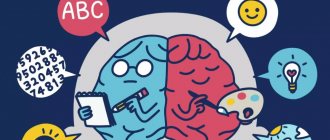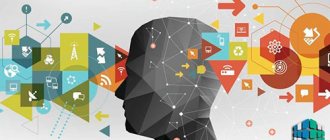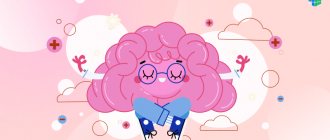Hello, beloved readers. It's been a while since I posted my new posts on the site. The topic of this publication is the role of thinking in human life .
The main feature that distinguishes humans from other mammals is the ability to think. This skill underlies the development of science, various types of art, and determines politics and religion.
In comparison with other forms of cognitive activity, thinking has one characteristic feature. It lies in the fact that a person, using the ability to think, observe and study any phenomena, gets the opportunity to analyze, compare and draw conclusions.
In simple words, thinking is the highest degree of the cognitive process. Its main forms are concept, judgment and inference.
Without thinking, not a single type of human activity is possible. Be it work, study or communication. It is closely related to such personality traits as will, motivation, abilities and emotions.
Systems thinking
Systems thinking helps to see the relationships between objects and phenomena, understand the context, correlation and causation of events.
Systems thinking is usually used to effectively solve problems. The essence of this thinking is that in order to understand how to solve a problem, you need not only to understand the problem itself, as a consequence, but to understand what led to its occurrence, what phenomena and factors caused its occurrence. This approach to solving the problem is that systems thinking develops nonlinearly, but in many directions simultaneously [Donella Meadows, “The ABCs of Systems Thinking,” 2018].
Study of the development of conceptual thinking in the school of L.S. Vygotsky. Vygotsky-Sakharov technique.
Conceptual thinking - (verbal-logical), one of the types of thinking, characterized by the use of concepts and logical constructions. Conceptual thinking functions on the basis of linguistic means and represents the latest stage in the historical and ontogenetic development of thinking.
In the structure of conceptual thinking, various types of generalizations are formed and function. Thinking is seen as a process expressed in words. Ugly thinking - there are no images in thinking, there are only words or logical operations. The sequence of mental mental operations is the process of thinking.
A concept is a form of thinking that reflects the essential properties, connections and relationships of objects and phenomena, expressed in a word or group of words.
N. Akh expressed the idea that thinking is carried out not in images, but in concepts. Adults have a formed system of concepts, and these concepts are presented in a collapsed form. In his methodology, Akh introduced the technique of forming artificial concepts. To do this, he used three-dimensional geometric shapes that differed in shape, color, size, weight - 48 shapes in total.
A piece of paper with an artificial word is attached to each figure: large heavy figures are designated by the word “gatsun”, large light figures are designated “ras”, small heavy figures are designated “taro”, small light figures are designated “fal”. The experiment begins with 6 figures, and from session to session their number increases, eventually reaching 48. Each session begins with the figures being placed in front of the subject, and he must lift all the figures in turn, while reading their names out loud; this is repeated several times.
After this, the pieces of paper are removed, the figures are mixed, and the subject is asked to select the figures on which there was a piece of paper with one of the words, and also explain why he chose these particular figures; this is also repeated several times. At the last stage of the experiment, it is checked whether the artificial words have acquired meaning for the subject: he is asked questions like “What is the difference between “gatsun” and “ras”?”, and is asked to come up with a phrase with these words.
L. S. Vygotsky and his collaborator L. S. Sakharov changed Ach’s methodology in order to more deeply study the meanings of words and the very process of their (meanings) formation. Ach's technique did not allow studying this process, since words were associated with the figures they denoted from the very beginning; “words do not act from the very beginning as signs; they are fundamentally no different from another series of stimuli appearing in experience, from the objects with which they are associated.”
Therefore, while in the Ach method the names of all the figures are given from the very beginning, the task is given later, after they have been memorized, in the Vygotsky-Sakharov method, on the contrary, the task is given to the subject at the very beginning, but the names of the figures are not. Figures of different shapes, colors, plane sizes, heights are placed in front of the subject in a random order; An artificial word is written on the bottom (invisible) side of each figure. One of the figures turns over, and the subject sees its name.
This figure is put aside, and from the remaining figures the subject is asked to select all of them that, in his opinion, have the same word written on them, and then they are asked to explain why he chose these particular figures and what the artificial word means. Then the selected figures are returned to the remaining ones (except for the one set aside), another figure is opened and set aside, giving the subject additional information, and he is again asked to select from the remaining figures all of the figures on which the word is written. The experiment continues until the subject correctly selects all the figures and gives the correct definition of the word.
Stages of development of thinking in ontogenesis. Theory of J. Piaget.
The theory of the development of a child’s thinking, developed by J. Piaget, was called “operational”. An operation is an “internal action, a product of transformation (“interiorization”) of an external, objective action, coordinated with other actions into a single system, the main property of which is reversibility (for each operation there is a symmetrical and opposite operation.
Describing the concept of reversibility, Piaget gives as an example arithmetic operations: addition and subtraction, multiplication and division. They can be read either left to right or right to left, for example: 5 + 3 = 8 and 8 - 3 = 5.
Thinking as a destination
If we consider the need for the thought process in a broader way, it turns out that we tend to go in circles. It is enough to make a list of topics that we think about regularly, every day. Will this daily flow of thoughts contain original, useful and truly breakthrough ideas for life?
If we figuratively imagine as a destination an idea that could qualitatively influence our lives up to radical changes, then the road to it would have many obstacles.
Abstract on the academic discipline “Psychology”
on the topic: “The importance of memory, thinking and speech in human life”
Plan
1. Introduction.
2. Human memory. Definition, methods of successful memorization, the importance of memory in human life.
3. Definition of the concept of “thinking”. Features of the thinking process and its types.
4. Definition of the concept “speech”. The connection between thinking and speech in human everyday life.
5. Conclusion.
6. List of references.
1. Introduction.
Thinking, speech and memory are human cognitive processes that provide him with the opportunity to retain what is imprinted in his consciousness, express the second and transfer it to another person.
Each word in the language system has a specific meaning. The meaning of a word is a generalization, i.e. the relationship of a word with certain phenomena of reality. A person, using words, thinks with the help of language. Speech is one of the forms of thinking. Thoughts are always expressed in speech form.
Memory is conditioned by a connection with speech and thinking, because thinking in its highest form is verbal-logical thinking. The conditioning of speech and memory is expressed by the organic combination of speech and thinking, as well as by the fact that in a person’s long-term memory, information is stored in the form of meanings and images of words. In other words, a person’s inner speech is a certain form of speech that stores information that has a specific meaning.
According to the above, it is possible to formulate a pattern of connection between speech and memory - the transition of information from the language of the senses to the basic language, which a person uses as thinking and a means of communication, promotes the movement of information from short-term memory to long-term memory, which contributes to its memorization. Speech is also involved in the reverse order - information is retrieved from long-term memory, then recalled.
Thus, when using speech in the process of memorizing material, as well as its recall, it helps to improve a person’s memory. Thus, in young children, simultaneously with the development of speech, a significant improvement in their memory can be observed. Consequently, the quality of a person’s memory depends on how completely he masters different types of speech. The development of speech is especially evident in the activities of a person, for whom it is a professionally necessary, obligatory quality. Such a person can retain and reproduce an exorbitant amount of information expressed in speech form.
2. Human memory. Definition, methods of successful memorization, the importance of memory in human life.
Memory is one of the forms of mental reflection, which consists in preserving, consolidating, and further reproducing past experience, facilitating the ability to reuse it in activity or return it to the area of consciousness.
Memory is the link between a person’s past, present and future, and plays a vital cognitive role in the basis of his development and learning.
Memory, its meaning. Images of phenomena and objects that appear in the brain as a result of their influence on the analyzers do not completely disappear after the end of this influence. Images tend to be preserved even in the inaccessibility of these phenomena and objects in the form of memory representations. Representations of memory are the mental reproduction of images, phenomena and objects previously perceived by a person. Representations are auditory, visual, tactile, olfactory, and gustatory. Memory representations are paler, less rich in variety of details and less stable, but they are an important element of past experience fixed by a person.
Memory is a reflection of human experience through storage, memorization, and reproduction. A person’s emotional disposition towards the thing being remembered has a significant influence on memorization. Something to which a person has a strong emotional reaction leaves a significant mark on the mind, is remembered for a long time and is thoroughly remembered. Also, memory productivity is largely influenced by a person’s volitional qualities.
Consequently, memory is determined by the characteristics of a person’s personality. He consciously adjusts his memory processes and coordinates them, based on the tasks and goals set in his activities.
Memory is the recognition of objects, this explains its connection with perception, because perception is impossible without recognition. Also, it should be noted that memory is an independent mental process, not associated with perception, when reproducing an object in its absence.
Memory is a complex process. As a basis for identifying memory processes, memory functions are considered. Memory processes include reproduction, memorization, preservation, and forgetting of material.
As a result of memorization, the new is consolidated by connecting it with the past. It should be noted that memorization is selective - not everything that affects the human senses is stored in memory. Memorization is the process of storing presented information in the mind in the form of thoughts, images, actions and experiences. There is a distinction between voluntary and involuntary memorization.
Involuntary memorization occurs on its own, as a result of an unintentional desire to remember something. Effective involuntary memorization occurs with active mental activity. For example, in most cases, the actor remembers the text of the role during rehearsal, but does not memorize it, because The main goal of rehearsals is to get used to the character, and not to master the words.
Voluntary memorization is the leading one for a person. Its emergence and development occurs during the communication of people and in their work activities. Voluntary memorization is a purposeful process - what exactly is remembered, why, for what time period, where and how to use it - this leads to organization and systematic memorization. Memorization is a special form of voluntary memorization. It is used when it is necessary to store something in memory extremely accurately and firmly.
Reproduction is the retrieval of material stored in memory. Similar to memorization, there is voluntary and involuntary reproduction. The process of involuntary reproduction is not purposeful, and usually does not occur on its own. Basically, the incentive for involuntary reproduction is any reason that evokes the appropriate associations. Reproduction is voluntary, if it is organized through a consciously set goal and the use of volitional efforts. A conscious motive is the main feature of voluntary reproduction. Recall is one of the transformations of random recall.
Retention in memory is retention over a long period of time and assimilation of what is remembered and deposited. Memory stores significant material that is repeated repeatedly, used in activities on an ongoing basis, clearly understood, or imprinted with the goal of “remembering for a long time.” The application of use to activity, in practice, is the basis of conservation. This applies to both knowledge and skills.
Forgetting is a process that is of great importance in the functioning of memory. Forgetting helps to get rid of numerous existing details and simplifies the implementation of generalization. The process of forgetting is inevitable and occurs mostly involuntarily. Sometimes it is easy to recognize, but difficult to reproduce what has been partially forgotten. Everything that is not regularly reinforced by repetition and perception loses importance for a person, is rarely used in his activities and is quickly forgotten. This is the positive side of forgetting.
Memory is a complex mental function that has various forms and types. The main types of memory are intravital and genetic (hereditary). Genetic memory mainly includes instincts and is practically not determined by human life. Genetic memory is stored in the genotype, reproduced and passed on by inheritance. This type of memory is the only one that a person cannot influence through education and training. The necessary biological, behavioral and psychological properties are transmitted from generation to generation genetically. Lifetime memory stores information that a person receives from the first days of life until death.
Lifetime memory can be classified according to the efforts made to memorize and the presence of a target setting; memory is divided into voluntary and involuntary. According to the degree of meaningfulness, memory is divided into semantic and mechanical.
There are several reasons for allocating memory types:
1) duration of storage;
2) the degree of conscious activity during reproduction and memorization;
3) the psychological content of what is remembered.
According to the degree of conscious activity, memory is divided into voluntary and involuntary. Arbitrary is also divided into mechanical and logical. According to the psychological content of what is remembered, verbal-logical, figurative, motor, and emotional memory are distinguished - it is characteristic of every person. Based on the duration of storage, memory is divided into long-term, short-term and operational.
Also, individual qualities between people are distinguished by memory accuracy, memory readiness, volume, duration of storage, and speed of memorization. Their combination makes it possible to divide people into four groups according to individual differences in memory:
1) those who quickly forget, but quickly remember;
2) those who forget slowly, remember firmly and quickly;
3) those who forget quickly and remember slowly;
4) remember for a long time, but remember slowly.
3. Definition of the concept of “thinking”. Features of the thinking process and its types.
Thinking is a psychological process, socially conditioned, having a strong connection with speech, the process of discovery and search for something radically new, as well as a generalized and indirect reflection of reality during its synthesis and analysis. The emergence of thinking is based on practical activity from sensitive cognition, which fundamentally goes beyond its boundaries.
First of all, thinking is a higher cognitive process, which is the formation of new knowledge, an active form of creative transformation and reflection of reality by a person. Thinking is also understood as the acquisition of new knowledge, the creative modification of existing ideas.
One of the features of thinking is its indirect nature. If a person does not have the opportunity to know something directly (immediately), then he knows indirectly (indirectly): the unknown - through the known, some through other properties. Thinking is constantly based on the data of sensitive experience - perception, ideas, sensations - and on theoretical knowledge acquired earlier. Another feature of thinking is its generality. Generalization is possible through the connection of all properties that are essential and general in the objects of reality during their cognition. The general manifests itself and exists only in the concrete, in the individual.
The results of human cognitive activity are recorded in the form of concepts. A concept is a reflection of significant features of an object. Based on numerous inferences and judgments about an object, a concept about it arises. Objects of reality, in their relationships and connections, are reflected in the form of judgment. An isolated thought about something is a judgment. Inference is a conclusion from various judgments that gives a person new knowledge about the phenomena and objects of the objective world. Inferences are distinguished by analogy, and there are also deductive and inductive ones.
In addition, thinking is firmly connected with human practical activity. Each type of activity involves taking into account the conditions of action, observation, thinking, planning. In action, a person is engaged in solving various problems. The criterion for the truth of thinking, as well as the main condition for the development and emergence of thinking, is practical activity. Human mental activity is the solution of diverse mental problems that are aimed at identifying the essence of something. The method of mental activity with which a person solves mental problems is a mental operation.
Mental operations are varied - comparison, abstraction, synthesis and analysis, classification, specification, generalization. Which logical operations a person will use depends on the nature and purpose of the information undergoing mental processing.
Synthesis is the combination of parts, relationships, properties, actions into one whole. Analysis is polar to synthesis; it is the process of mental isolation from a whole of its actions, relationships, sides, or mental decomposition of the whole into parts. Synthesis and analysis are interconnected logical operations. A person in his work activity continuously interacts with phenomena and objects. Their practical development leads to the formation of mental operations of synthesis and analysis.
Comparison is the determination of differences and similarities between phenomena and objects. The comparison is based on analysis. Before comparing objects, their characteristics are identified by which the comparison will be made. Comparison can be both multilateral - more complete, and one-sided - incomplete. Comparison, like synthesis and analysis, can be deep and superficial.
Abstraction is a mental distraction from the aspects of the concrete, some signs for its better knowledge. Mentally, a person identifies any feature of an object, considers it separately from other features, distracting himself from them for a while. With the help of abstraction, man was able to separate himself from the concrete and individual and approach the highest point of knowledge - scientific theoretical thinking.
Concretization is a process continuously interconnected with abstraction, but the opposite process. Concretization is the reversion of thought from the abstract to the mediated, to reveal the content. Mental activity is continuously aimed at obtaining some result.
Regarding the place in the thought process that image, action and word occupy, how they are compared to each other, three types of thinking are defined: abstract, concrete-figurative and concrete-figurative. These types of thinking are also distinguished on the basis of the characteristics of the tasks - theoretical and practical. Abstract - verbal-logical - is carried out through logical operations with concepts. Concrete-figurative - visual-figurative - is based on images and ideas. The concretely effective—visually effective—relies on the direct perception of objects. These types of thinking are closely interconnected. Many people have equally developed concrete-figurative, theoretical and concrete-actional thinking, but regarding the nature of the tasks a person solves, all three types of thinking come to the fore in turn.
Visual-figurative, theoretical-abstract and practically-effective - these are interconnected types of thinking. During the historical development of mankind, the development of human intelligence initially occurred through practical activity. The initial type of thinking is practical-actional, which is determined by actions with objects. On the basis of manipulative thinking comes visual-figurative thinking; it is characterized by operating with visual images in the mind. The highest degree of thinking is abstract thinking. But even here the connection with practice remains. The thinking of individual people is also divided into figurative, abstract and practical.
And yet, in the process of human life, both types of thinking alternately come to the fore. For example, when reporting on a scientific topic, a person uses theoretical thinking, and in everyday affairs - practical thinking.
According to content, mental activity is divided into artistic, scientific and practical. The structural unit of artistic thinking is an image, of scientific thinking is a concept, of practical thinking is action.
According to the depth of generality, theoretical and empirical thinking are distinguished. Theoretical thinking examines the object of knowledge in the totality of its necessary connections and reveals general relationships. Empirical thinking produces initial generalizations based on experience. These generalizations are made at a low level of abstraction. Empirical knowledge is the lowest simple level of knowledge.
According to the standardity - non-standardity of operational procedures and tasks to be solved, heuristic, algorithmic, creative and discursive thinking are distinguished. Heuristic thinking—productive thinking—is aimed at solving unique problems. Algorithmic thinking is aimed at a generally accepted sequence of actions, pre-assigned rules required to solve standard problems. Creative thinking leads to fundamentally new results, to new discoveries. Discursive thinking is based on the construction of interconnected conclusions.
They also distinguish between productive and reproductive thinking. Productive - directs to new cognitive results. Reproductive is the reproduction of previously obtained results - here thinking comes into contact with memory.
4. Definition of the concept “speech”. The connection between thinking and speech in human everyday life.
By its definition, speech is multifunctional in nature. It is the basis of a means of communication between people, a means of regulating one’s own behavior and the behavior of another person, a means of thinking, the owner of memory and consciousness, a carrier of information - writing. Speech is the process of verbal communication, the expression of a certain thought.
Language is a system of conventional signs that convey combinations of sounds that have a certain meaning and meaning for a person. Speech is an expression of the psychology of a particular person, and language is a reflection of the psychology of the entire people speaking in a given language. The meaning of a word is expressed in units of speech and in units of language, and is a unifying link between them.
The meaning of a word is always the same, but the meaning can be different. Speech arose in the process of historical development along with thinking. Initially, it has social and communicative meaning for people. However, a person uses speech both when he wants to make logical arguments in relation to various life situations, and during daily communication, interaction in educational, work, play or other activities. The desire for joint activities leads to communication.
Communication is the exchange of information, language is a system of signs. A person’s experiences and thoughts are first clothed (encoded) in written (letters, images) or oral (sounds) signs in order to transmit them to another person. The meaning (meaning) of experiences and thoughts will be clear to a person if he knows the language in which communication takes place. Communication between people occurs not only through language, but also through other signs: signs of art, scientific symbols, traffic signs, marine signaling. The science of signs, sign systems, as well as linguistic signs, is called semiotics.
Dialogue is the simplest type of oral speech. Dialogue is a speech in which the interlocutor actively participates, and it is curtailed due to the understanding and knowledge of the situation by the partner.
Monologue speech is a person’s extended speech that is addressed to other people. The speaker must have the ability to consistently and coherently express his thoughts in a complete form. Monologue speech carries a communicative and pronounced expressive function - pauses and intonations, facial expressions and gestures that emphasize the speaker’s attitude to the content of the conversation. Written speech is a type of monologue speech that is built through written signs.
The main types are divided into impressive and expressive speech, which have different psychological structures.
Expressive speech - the process of utterance - written or oral speech, begins with an idea - a plan of utterance, then passes into the state of internal speech, which has a compressed character, and finally passes into the state of an expanded external utterance - written or oral.
Impressive speech - understanding a speech utterance - written or oral. It begins with the perception of information through vision or hearing, then moves on to decoding and ends with the creation in internal speech of a model for presenting information and its understanding.
Inner speech is closed from direct observation and is characterized by convolution; it is deliberately adapted to the execution of mental operations and actions in the mind.
The connection between thinking and speech. The thinking of a normal, adult person is indisputably connected with speech. Thought is conditioned by its emergence, flow, and existence in speech and language. A person thinks in words that he speaks to himself or says out loud, i.e. thinking occurs in the form of speech. People who are fluent in several languages are clearly aware of which language they are thinking in at a particular moment. In speech, thought is not only built, but also formed and developed.
With special devices it is possible to record hidden speech - articulatory micro-movements of the tongue, lips, larynx, which certainly accompany human mental activity, for example, when solving various problems. Only people who are deaf and mute from birth, who do not even speak kinetic - “manual” - speech, think based on images.
At times it seems that thought flows outside the verbal shell, that it is difficult to put any thought into words. However, this means that the idea is still vague, that it is rather a vague general idea. A clear thought is continuously connected with a clear verbal definition.
The opposite opinion is also incorrect: that speech and thought are actually the same thing, that thinking is speech that is devoid of sound, and speech is voiced thinking. This opinion is incorrect, because one and the same thought can be expressed in different languages with a large number of different sound combinations. It is also well known that there are homonym words - the same word can express different concepts, different thoughts - words with different meanings, but the same sound: root, braid, reaction, key.
5. Conclusion.
The connection between cognitive processes and human speech is historical in nature. This connection is created only at a predetermined stage in the history of the development of expedient cognitive processes. When the processes reach a higher level in their development, they are transformed into higher mental functions, then this connection turns out to be so organic and natural for them that it seems as if it is inherent in these cognitive processes.
Every thought is created and developed in a strong connection with speech. The more thoroughly and deeply a thought is thought out, the clearer and more clearly it is expressed in words, in written and oral speech. In the word, in the formation of thought, there are important necessary preconditions for discursive, that is, logically dissected, conscious and reasoning thinking. At the same time, at an early age, with the development of speech, memory significantly improves. A person can store and reproduce countless amounts of information expressed in speech form.
Consequently, human thinking and memory are indivisibly connected with speech, with language. Thinking needs to be in a verbal, material shell, and in memory information is stored in the form of meanings and images of words.
6. Bibliography.
1. A.G. Maklakov, General psychology. - St. Petersburg: Peter, 2001. - 592 p. — Series “Textbook of the New Century.”
2. I. V. Dubrovina, Psychology: Textbook for students. avg. ped. schools, institutions / I. V. Dubrovina, E. E. Danilova, A. M. Prikhozhan; Ed. I. V. Dubrovina. - M.: Publishing House, 2004. - 464 p.
3. R. Atkinson, Human memory and the learning process / Trans. from English under general editorship Yu. M. Zabrodina, B. F. Lomotsa. - M.: Progress, 1980. - 528 p.
4. G.A. Kuraev, E.N. Pozharskaya, Human Psychology: Lecture 10 – Thinking. – Rostov-on-Don: Phoenix, 2002. – 232 p.
5. O.Ya. Goikhman, T.M. Nadeina, Speech communication. M.: INFRA-M, 2003. - 272 p.
Functions and processes of thinking
Any type of thinking implements a certain set of processes that provide knowledge of the world around us.
:
- Comparison – comparison of objects and phenomena, highlighting their similarities and differences;
- Analysis – dividing an object or phenomenon into components;
- Synthesis is the opposite process to analysis, in which a whole is reconstructed from individual elements by establishing connections and relationships;
- Abstraction – highlighting one distinctive property of an object while ignoring all other, less significant ones;
- Generalization – discarding individual features to preserve and comprehend common ones, establishing significant connections.
At the same time, a small child needs to carry out these actions literally: disassemble, put objects, arrange them according to certain characteristics. It is enough for an adult to mentally imagine all these actions.
According to their functions, types of thinking in psychology are divided into reproductive, productive and creative. The first type is repetition of learned rules according to a given algorithm; This is how, for example, typical problems in textbooks are solved. Here, thought processes are aimed not at obtaining new knowledge, but at consolidating existing material. The second type is productive thinking, in which a person goes beyond existing knowledge and receives some new information; Moreover, they are new only for a given individual, but not for humanity. If the information obtained in this way is new for humanity, then the third type is involved here - creative thinking. In this case, thought processes acquire special complexity and structure.
Visual-figurative thinking is subject to a single algorithm. First, a person gives one judgment, then adds another to it, and on their basis makes a third judgment - a conclusion. It is the goal of thought processes.
Let's sum it up
The importance of thinking in a person’s life for the formation of a successful personality is enormous.
Without it, no individual will be able to benefit from the knowledge he needs. Conversely, the maximum benefit even from a minimum of information can be obtained with sufficiently developed mental activity. Human nature is unique. We are a fairly young species of living beings that were able to rise to the top of the food chain on planet Earth. Only by developing intellectually will we be able to conquer new limits of reach and achieve success. Go for it!
This concludes the story. See you soon. Bye!
Why is abstract thinking needed?
Abstract thinking develops the creative side of a person. Creativity is needed by people of all professions. It helps you come up with new ideas, projects, and look for unexpected tools to perform complex or everyday tasks. A creative approach improves a person's overall quality of life and increases their efficiency. Abstract thinking is considered an advanced skill.
People who can think abstractly:
- successfully pass tests for developed intelligence;
- solve complex problems;
- are inclined towards different types of art;
- generate new ideas and directions;
- look at projects in perspective;
- think outside the established framework;
- find inconsistencies.
Let's explain abstract thinking through humor. Comedians observe themselves and the world around them, collect and analyze information and turn it into stand-ups and miniatures. Their jokes are often based on non-obvious connections, noticed using abstract thinking. People in other professions can use this tool to bring ideas from related or distant fields into their work.
Thanks to abstract thinking, comedian Nurlan Saburov compares a child’s ultrasound with communicating on Skype
Gardner's classification of intelligence
American scientist Howard Gardner became the author of the theory of “multiple intelligences”. According to it, a person has a wide range of cognitive abilities that have little dependence on each other. For example, a person who is easy in mathematics is not necessarily smarter than someone who has difficulty in this subject. Anyone who spends more time and effort to solve a problem or example has certain advantages:
- he learns to come to a decision in other ways;
- gets the opportunity to successfully implement himself in other areas that are not related to mathematics;
- often seeks an answer to a problem using mechanisms different from those used by the “mathematician.”
Often such an understanding of the subject (in the described situation - mathematics) from the outside may seem slow. However, such a definition is fundamentally incorrect. Behind it often lies the intellect of a very strong mathematician who sees solution possibilities at a deeper level than someone who “clicks” problems according to a memorized pattern.
In his books, Gardner talks in detail about how he sees different types of intelligence
person. Let's take a brief look at them too.
Logical-mathematical
People with dominant logical-mathematical intelligence easily cope with tasks related to the need to perform mathematical operations, operate with numbers and specific concepts. Those who have a predominant logical-mathematical intelligence are more willing to spend time alone with numbers, creating codes, puzzles, and logical tasks. The scope of application of abilities is very wide. Often people become:
- programmers;
- mathematicians;
- logistics specialists;
- financiers;
- engineers;
- analysts;
- composers.
Talented detectives, capable of finding connections between facts and events that are invisible to others, also have logical-mathematical intelligence.
Verbal-linguistic
The predominance of this type of intelligence makes it possible to express thoughts very clearly and competently, to transform even the most complex ideas and thoughts into a coherent and understandable text. People with dominant verbal intelligence love communication. They talk in such a way that their interlocutors are always very interested, they have the gift of persuasion, and skillfully use facts. Often, verbal intelligence helps a person become a leader.
The dominant type of intelligence is reflected in the professional choices people make. They often become:
- writers;
- journalists;
- historians;
- actors.
Among those whose verbal intelligence dominates, there are many people with dyslexia. This disorder does not prevent them from being very successful in professions related to communication and the ability to express themselves beautifully and clearly.
Visual-spatial
This type of intelligence is otherwise called figurative. Those in whom it dominates easily manage to remember the pictures they see. Humans have exceptional visual memory. They are able to see a whole page of text once and after a while reproduce its contents or remember the facial features of a person seen only once. But the material that they had to learn by heart is forgotten very quickly.
Often people with spatial-visual intelligence become:
- builders and architects;
- artists, sculptors;
- engineers;
- sailors, pilots.
What helps them achieve success in their chosen field is the ability to notice even the most insignificant details that are invisible to others, the ability to imagine how different objects might look or be located in space. Well-developed spatial intelligence allows you to easily navigate the area and make sketches based on verbal descriptions.
Naturalistic
The naturalistic or nature-oriented type of intelligence is manifested in people who easily interact with the animal and plant world. They notice everything around them, study with interest animals and plants, their characteristics, the processes occurring with them, easily give descriptions and systematize species.
Among people with natural intelligence there are many:
- biologists;
- farmers;
- veterinarians;
- chemists;
- agronomists;
- gardeners;
- cooks;
- chemists.
Many realize their natural naturalistic intelligence in communication with nature - creating interesting compositions from plants, walking in the forest, near the river.
Interpersonal or interpersonal intelligence
It prevails in people who have a good sense of mood, emotions, and understand the desires of others. With developed interpersonal intelligence, the ability to easily establish interactions even with strangers is very noticeable.
People with well-developed interpersonal intelligence become:
- teachers;
- psychologists;
- HR specialists;
- social workers.
Outside of the work environment, they appear as interesting interlocutors, those on whose help you can always count.
Intrapersonal or intrapersonal intelligence
People with well-developed intrapersonal intelligence are focused on their inner world. They think a lot, reflect, often well understand the reasons for their own emotions and actions, and cope with stressful situations relatively easily.
Those in whom this type of intelligence dominates choose a profession:
psychologist;
philosopher;
writer;
historian.
The intrapersonal type of thinking is considered the most difficult. Those for whom it prevails are actively interested in global problems, think a lot about the meaning of life and other existential issues.
Musical-rhythmic
Abilities of this type appear already in the first years of life, when the child listens to music, tries to hum melodies, sways with pleasure to the beat of the music or beats out a rhythm. Such kids grow up to be talented musicians or simply music lovers.
Kinesthetic (bodily)
For people with a predominance of bodily intelligence, knowledge of the world occurs through tactile sensations. They help to understand the properties of objects, their shape, and form their attitude towards them. There are a lot of athletes among bright kinesthetics;
- dancers;
- massage therapists;
- doctors.
Their ability to react very sensitively through touch is combined with well-developed spatial thinking.
Emotional
This type of intelligence is called perhaps the most important for effective interaction with other people and achieving good results in all areas of life. Emotional intelligence is associated with the ability to deeply understand one’s own and others’ emotions, their origins and ways to manage them in the most environmentally friendly way.
Well-developed emotional intelligence helps people in helping professions - doctors, psychologists, social workers - in their work. It is necessary for teachers, human resources specialists and all those who work in contact with other people.
Ideally, every person should work on “pumping up” their emotional intelligence, regardless of their age and profession. Then many difficulties and problems that prevent you from moving through life confidently and experiencing satisfaction will disappear.
Irina Sherbul
How to develop thinking
As you can understand from our article, thinking is a skill that can and should be constantly developed. To improve your analytical, creative and strategic abilities, you must first set clear goals for yourself. You will find useful tips on developing your thinking in our articles “How to change your thinking” and “Developing your thinking: ways to train your brain.”
Moreover, we have excellent courses to develop different types of thinking. In the “Cognitive Science” course, we have prepared more than 20 techniques that will teach you to reason effectively and logically, make quick decisions and find innovative solutions to various problems, and the “Neurosciences” program will improve your memory, visual thinking and ability to concentrate.
Also, be sure to pay attention to the programs, articles and courses to which we provided links, and below you will find links to materials used in writing the article - they may also be useful to you:
- Maria Falikman, “Types of thinking.”
- Roem Dan, “Visual Thinking: How to Sell Your Ideas with Visuals,” 2013.
- Barry Buzan, Superthinking. Change your life with mind maps", 2021.
- Bill Burnett, Dave Evans, Designing Your Life. Live the way you need”, 2021.
- Donella Meadows, The ABCs of Systems Thinking, 2021.
- Ian McDermott, Joseph O'Connor, The Art of Systems Thinking. Essential knowledge of systems and creative problem solving", 2021.
- Barry J. Nalebuff, Avinash Dixit, Game Theory. The art of strategic thinking in business and life", 2021.
- Pavel Avraamov, “Go Strategy. An ancient game and modern business, or how to win the competition", 2021.
- Stephen Sloman, Philip Fernbach, The Illusion of Knowledge. Why we never think alone,” 2021.
- Daniel Kahneman, Think Slow, Decide Fast, 2014.
- Tom Chatfield, Critical Thinking. Analyze, doubt, form your opinion”, 2021.
- Howard Gardner, Future Thinking. Five types of intelligence leading to success in life", 2015.
- Michael Mikalko, Creative Explosion, 2013.
- Tony Buzan, Mind Maps. The Complete Guide to Powerful Intelligence", 2021.
Experimental studies of animal thinking in behaviorism.
American scientist Edward Thorndike (1874-1949), along with I. P. Pavlov, is considered the founder of the scientific method of studying the learning process in animals under controlled laboratory conditions. He was the first psychologist to apply an experimental approach to the study of the psyche of animals. This approach was proposed somewhat earlier by the German scientist Wilhelm Wundt (1832-1920) for studying the human psyche, as opposed to the dominant method of introspection at that time, based on introspection.
E. Thorndike in his research used the method of so-called “problem cells” - universal problems for animals. An animal (for example, a cat) was placed in a locked box, from which it was possible to exit only by performing a certain action (pressing a pedal or lever that opens a latch). For mice and rats, another type of basic task was invented - a maze.
The behavior of the animals was the same, they made many random movements: they rushed in different directions, scratched the box, bit it - until one of the movements accidentally turned out to be successful. On subsequent trials, the animal needed less and less time to find a way out until it began to act without error. The data obtained (“learning curve”) gave grounds to assert that the animal acts by “trial and error”, accidentally finding the right solution. This was also evidenced by the fact that, having once made the right action, the animal continued to make many mistakes.
Thus, the main conclusion of the experiments was that the formation of new connections occurs gradually, this requires time and many trials.
Experimental studies of thinking in Gestalt psychology. Stages of development of the thought process.
Gestalt psychologists believed that thinking does not depend on experience, but only on the image of the situation. For scientists belonging to this direction, the concept of insight became the key, the basis for explaining all forms of mental activity.
The phenomenon of insight was discovered by W. Keller while studying the intelligence of chimpanzees. Based on the fact that intellectual behavior is aimed at solving a problem, Keller created “problem situations” in which the experimental animal had to find workarounds to achieve the goal. The operations that the monkeys performed to solve the task were called “two-phase”, because consisted of two parts.
In the first part, the monkey had to use one tool to get another one necessary to solve a problem (for example, using a short stick that was in a cage, get a long one lying at some distance from the cage). In the second part, the resulting tool was used to achieve the desired goal, for example, to obtain a banana that was far from the monkey.
Thinking was seen not only as establishing new connections, but also as restructuring the situation. To solve the problem, all objects had to be in the field of view.
Keller's experiments showed that solving a problem (restructuring a situation) occurs not by blindly searching for the right path (using trial and error), but instantly, thanks to the spontaneous grasp of relationships, understanding (insight). That. insight was seen as a way of forming new connections, a way of solving problems, a way of thinking. Keller argued that the moment phenomena enter another situation, they acquire a new function.
Combining objects in new combinations associated with their new functions leads to the formation of a new image (gestalt), the awareness of which is the essence of thinking. Keller called this process the restructuring of gestalt and believed that such restructuring occurs instantly and does not depend on the past experience of the subject, but only on the ways in which objects are arranged in the field.
The following stages of problem solving (thinking) were identified:
1) Accepting the task and studying the conditions.
2) Application of old solutions.
3) Hidden phase (accompanied by negative emotions).
4) Insight, “aha reaction” (accompanied by positive emotions).
5) The final stage (obtaining the result, formalizing the solution to the problem).
K. Duncker conducted experimental studies with adults, during which he asked subjects to solve various original creative problems (the X-ray problem). The subjects were asked to voice everything that came to their minds; the experimenter was in an interaction with the subjects.
As a result, Keller’s main provisions on solving a problem based on insight and the stages of solving a problem were confirmed. However, according to Duncker, insight is not instantaneous, but rather pre-arranged. The process reveals two types of solutions: functional and final.
Slow thought
According to researchers, a person cannot think qualitatively slowly for a short time - this process takes only 2% of the total time in which intellectual load is involved. The reason for such a low percentage is the factor of cognitive laziness. Deep slow thinking, analysis and comparison require too much energy that we do not give.
Confounding factors
Now it’s worth taking a closer look at what exactly prevents us from thinking qualitatively:
- Distractions and low ability to concentrate on thoughts.
- Deep, long-term thinking requires energy that we simply don't want to waste.
- Fear of negative thoughts affects an objective assessment of the situation.
- The previous experience of making wrong decisions also prevails, constantly directing us to the same habitual and ineffective models of action.
- The influence of beliefs and attitudes that violate even logical chains in the thinking process, but we cannot get rid of them due to ingrained habits.
You can ask a simple question: “Why do we not see and succumb to such failures and distortions?” For the same reason that we don't even have time to think about it. In addition, we strive to solve everything in simpler and shorter ways, requiring fewer resources, including neuron voltage.
Sweet sandwiches for a family tea party: preparing a dessert from cookies and biscuits
Who helped Pugacheva become more popular than Rotaru: the opinion of Sergei Sosedov
Why foreigners admire our grandmothers: 5 reasons to remember











